Familia: Climaciaceae ⇾Genus: Climacium ⇾Species: Climacium dendroides & Climacium americanum
Genus name: Climacium • コウヤノマンネングサ属 • ko-u-ya-no man-nen gusa zoku (literally “Kouya’s perennial grass” + zoku=genus)
About genus: Tree mosses – any of the plants of the genus Climacium -are large (5-10 cm) and resemble miniature evergreen trees; they are found mostly throughout the Northern Hemisphere.
The generic name Climacium is derived from the Greek for a little ladder, referring to the appearance of the inner teeth.
Six species are known at present, 4 or 5 grow in Japan and 2 in North America:
• Climacium americanum– American climacium moss
• Climacium dendroides– tree climacium moss, sometimes called European tree moss
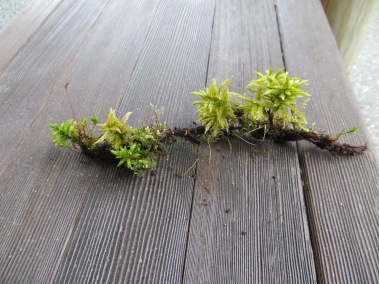
SJG • 3/4/17 – Climacium spreads through strong, horizontal, subterranean primary stems, on which dendroids grow on secondary erect stems (the capsule is of Atrichum, NOT Climacium) The bench slats are 2.75″ (7 cm) wide
Species description: Frankly, we don’t know which particular species of Climacium grows in SJG, and the latest edition of ‘Flora of North America’ (volume 27 &28) lists both C. americanum and C. dendroids as occurring in WA State.
Noteworthy:
1.) Many bryologists questioned the distinction between C. dendroides and C. americanum (e.g. Lawton, 1971).
2.) Sometimes you will see references to a separate C. kindbergii, which is recognized by some authors on the varietal level, while others interpret it as modification of C. americanum growing in continuously flooded habitats [see note * below].
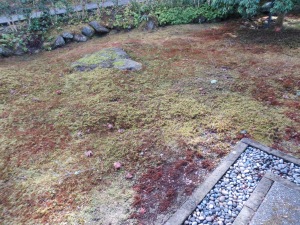
SJG • 2/14/17 – Climacium colony at the SW corner of the Tea House – dull green patch right at the corner, irregularly spreading towards the stone
The species description here is of Climacium dendroides • フロウソウ • fu-ro-u-so-u [literary ‘not-aging grass’ – see the translator’s note** below], but the differences between the species are small and hard to see without a lens and/or a microscope (the tips of leaves and parts of the capsule are slightly different). In Japan C. dendroides was found present on all the four big islands: Hokkaido, Honshu, Shikoku and Kyushu.
Climacium dendroides moss appears to be upright (apocarpous) but it’s actually classified as spreading (pleurocarp), because it grows through a strong
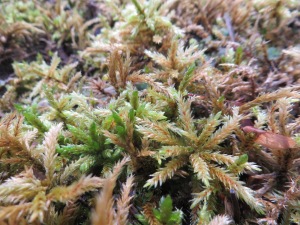
SJG • 2/14/17 – close up of the Climacium in SW corner of the Tea House; seen from above
horizontal, subterranean primary stem. The visible parts, the tree-like dendroids, are actually on secondary erect stems.
These plants are typically dark dull green, but sometimes also yellow-brown in color. At the time the pictures were taken for this post (February and early March) the plants are still pale green.
Sporophytes are rarely produced, so observing them is often difficult, as the Climacium has been known to produce extensive clonal populations geographically separated between female and male individuals. The sporophores arise from the secondary stems on long, erect setae, which are sometimes clustered. The capsules are erect, smooth, cylindrical, and symmetric. The clustered capsules on Climacium look like miniature cattails [*** see link to the picture of sporophyte]
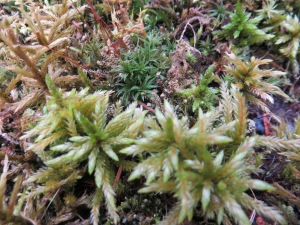
SJG • 3/4/17 – Big and smaller moss: Climacium (foreground) next to Atrichum (small dark green tuft above, in the middle of the picture)
Habitat: Climacium mosses are common in shady woods, in damp places on decayed logs, on roots of trees and on hummocks in swamps.
Distribution: Climacium dendroides occurs from northern and central Europe into Asia and North America with a disjunct distribution on the southern island of New Zealand. Climacium japonicum is endemic to Japan.
In North America Climacium dendroides is typically found from the subarctic area of Alaska to northeastern Quebec, and south to Pennsylvania in the east and California in the west, while Climacium americanum is typically found in the southern, mainland United States area. Climacium kindbergii is usually segregated to niches with a higher water level than the other two species.
SJG notes:
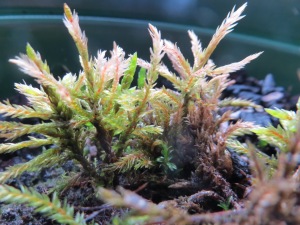
3/5/17 • Climacium in pot, seen from the side
So far Climacium was only found in the Tea House Garden, in roji proper; about a year ago a handful of plants appeared on the south side of Tea House entrance, and it quickly spread, which we observed during weekly cleaning of the rojii’s mosses. By now (March 2017) it formed several fairly large colonies, one (about 2 meters in diameter) easily observed on the SW corner of the Tea House graveled edge.
This fairly large moss forms distinctive mats of bottle green and yellowish color; a few smaller mats are under the trees near the south fence of the Tea House.
Polish species name of Climacium dendroides: Drabik drzewkowaty
References and related reading:
* This info is from an article in Systematic Botany Journal, 1994; Systematics of Tree Mosses (Climacium: Musci): Genetic and Morphological Evidence by A. Jonathan Shaw, Michael S. Gutkin and Bryan R. Bernstein]
** From Cara Izumi, translator of Japanese names:
Genus: Climacium コウヤノマンネングサ属. [ko-u-ya-no man-nen gusa zoku is the kana-ization of 高野の万年草, which is literally “Kouya’s perennial grass”. Kouya, I’m pretty sure, is a reference to an area in Wakayama Prefecture. Maybe this moss is common there? The area is mountainous, for sure, and famous for an important pilgrimage walk (google Mt. Koya!). 高野 is ‘Koya’; の is a participle indicating ownership; 万年 is literally ‘10,0oo years’, but it’s often used to indicate eternity or a perennial nature; and 草 means ‘grass’. Please remember that kanji characters can be read in several ways, so just because a character is pronounced one way doesn’t mean it’s always pronounced that way when you come across it again. And, you already know what ‘zoku’ means.]
Species: Climacium dendroides (Grows on Hokkaido, Honshu, Shikoku, Kyushu). フロウソウ. [fu-ro-u-so-u – this probably comes from a plant called 不老草, read the same way, meaning something like ‘not-aging grass’. It’s been considered a divine grass. The last character, 草 (so-u), is the one for ‘grass’; 不 (fu) means ‘not’ or ‘without’; and 老 (so-u) means ‘aged’ or ‘old’. ]
*** ‘Moss Plants and More’ blog has a picture of Climacium dendroides sporophyte, as well as interesting notes
• Ohio University has a good write-up on 2 Climacium (+ C. kindbergii) species on American continent
• Encyclopedia Britannica short but easy to read write-up on Tree Moss
• Michael Becker has a page in English on Climacium dendroides with a picture (most of the website is in German and French, but if you click on ‘Species’ on the top of the page it’ll take you to a page on central European mosses, the ones bolded are in English)
• Literary reference: ecological note
Tree mosses got their name because they LOOK like miniature trees, so it’s especially gratifying to find a word on mosses in a book about their big counter-parts, trees.
In his 2015 book ‘The Hidden Life on Trees’ Peter Wohlleben (link to NYT review) wrote about his experiences as a professional forester, originally trained to look at the trees from the point of view of optimizing the lumber industry. But he learned that the trees are healthier, stronger (and even more productive) if their ecological needs are respected. That convinced Wohlleben’s employer in the Eifel mountains in Germany to change the ways of managing their forest.
On page 64 he notes ‘[…] In central Europe there are no longer any true old-growth forests. The largest extensive stand of trees is between two hundred and three hundred years old. Until the forest preserves become old-growth forests once again, we must look to the west coast of Canada to understand the role played by ancient trees. […]’. He goes on to cite research from the Canadian universities about the large quantities of moss on the branches of trees at least 500 years old, and mutual benefits between the mosses and the trees. On page 166 and 167 he goes into how the mosses deal with getting food and light in the ancient forest.
The overall message of the book is that ecologically undisturbed communities of trees and whatever else naturally grows with them, are much stronger because they provide each other with support, ‘friendship’ and security for the whole community, while planted forests, because their roots are irreparably damaged when they are planted, seem almost incapable of networking/helping one another, affecting their health and stability.

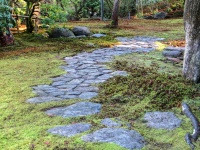
Skype has launched its online-structured client beta towards the world, following launching it broadly from the Usa and You.K.
before this four weeks. Skype for Internet also now supports
Linux and Chromebook for instant text messaging interaction (no video and voice yet, all those require
a plug-in set up).
The increase of the beta provides assist for a longer set
of dialects to assist reinforce that overseas usability
LikeLike
I sure would like to get some counsel on how I can successfully grow Tree Moss in the shady parts of my lawn here in NW Ohio. If someone would email me, that would be wonderful! Gratefully, Dan McCartney; dn.mccartney@gmail.com
LikeLike
I’m just a Seattle Japanese guide who runs this blog, Dan. Not an expert, at all. As far as I know there is NO way to force moss on anything – it lives quite independently and grows wherever it wants,alas. Independent from our wishes, I’m afraid. Best of luck in your Ohio moss interest! Thanks for your email! Aleks, the SJG guide Sent from my toaster oven
>
LikeLike
Dear Aleks (my sp?),
Thank you for the thoughtful and witty reply to my moss question; I truly appreciated it. Indeed, we can’t think of moss as off the shelf nursery stock, for it has a mind of it’s own. Thanks for your thoughts, Dan
LikeLike